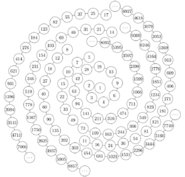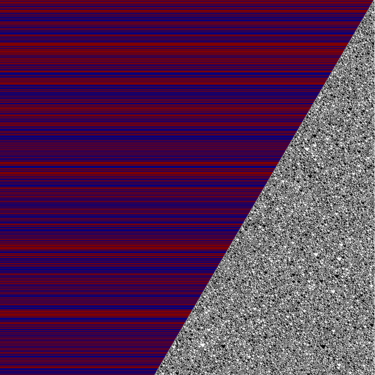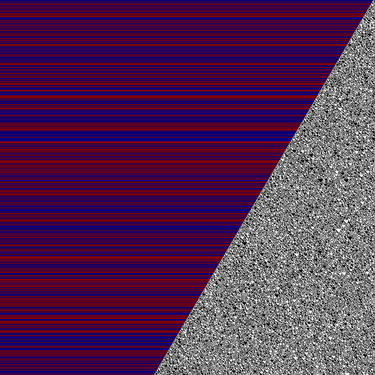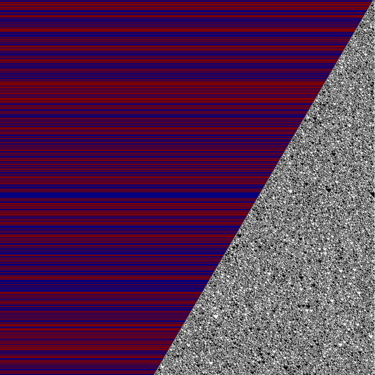Hydra function: Difference between revisions
Reworded content in the page |
m math format |
||
| (14 intermediate revisions by 4 users not shown) | |||
| Line 1: | Line 1: | ||
[[File:Hydra | [[category:Functions]] | ||
[[File:Hydra Spiral.png|thumb|185px|A spiral-like figure that gives the first few terms of the Hydra sequences with initial values 2, 5, 8, 11, 14, and 17.]] | |||
The '''Hydra function''' is a [[Collatz-like]] function defined as: | The '''Hydra function''' is a [[Collatz-like]] function defined as: | ||
<math display="block">\textstyle H(n)\equiv n+\ | <math display="block">\textstyle H(n)\equiv n+\big\lfloor\frac{1}{2}n\big\rfloor=\Big\lfloor\frac{3}{2}n\Big\rfloor=\begin{cases} | ||
\frac{3n}{2}&\text{if }n\equiv0\pmod{2},\\ | |||
\frac{3n-1}{2}&\text{if }n\equiv1\pmod{2}. | |||
\end{cases}</math> | \end{cases}</math> | ||
It is named as such | It is named as such because of its connection to the unsolved halting problems for the [[Cryptids]] [[Hydra]] and [[Antihydra]]. Due to its simplicity, simulations for both of these [[Turing machines]] utilize this function instead of what can initially be proven. | ||
== Relationship to Hydra and Antihydra== | == Relationship to Hydra and Antihydra problems== | ||
Using the Hydra function, we can obtain simplified rules for Hydra and Antihydra: | |||
{|class="wikitable" | |||
! Hydra !! Antihydra | |||
|-align="center" | |||
|Let <math>C_H(a,b):=0^\infty\;\textrm{<}\textrm{A}\;2\;0^{3(a-2)}\;3^b\;2\;0^\infty</math>:<math display="block">\begin{array}{|lll|}\hline | |||
0^\infty\;\textrm{A}\textrm{>}\;0^\infty&\xrightarrow{20}&C_H(3,0),\\ | |||
C_H(2a,0)&\xrightarrow{54a^2-48a-2}&0^\infty\;3^{9a-8}\;1\;\textrm{A}\textrm{>}\;2\;0^\infty,\\ | |||
C_H(2a,b+1)&\xrightarrow{54a^2-39a-5}&C_H(3a,b),\\ | |||
C_H(2a+1,b)&\xrightarrow{4b+54a^2-3a+4}&C_H(3a+1,b+2).\\\hline | |||
\end{array}</math> | |||
|Let <math>A_H(a,b):=0^\infty\;1^a\;0\;1^{b-4}\;\textrm{E}\textrm{>}\;0^\infty</math>:<math display="block">\begin{array}{|lll|}\hline | |||
0^\infty\;\textrm{A}\textrm{>}\;0^\infty&\xrightarrow{11}&A_H(0,8),\\ | |||
A_H(a,2b)& \xrightarrow{2a+3b^2-1}& A_H(a+2,3b),\\ | |||
A_H(0,2b+1)&\xrightarrow{3b^2-3b-7}& 0^\infty\;\textrm{<}\textrm{F}\;110\;1^{3b-6}\;0^\infty,\\ | |||
A_H(a+1,2b+1)&\xrightarrow{3b^2-7}& A_H(a,3b+1).\\\hline | |||
\end{array}</math> | |||
|} | |||
<div class="toccolours mw-collapsible mw-collapsed">'''Proof'''<div class="mw-collapsible-content"> | |||
Recall the high-level rules for Hydra and Antihydra: | Recall the high-level rules for Hydra and Antihydra: | ||
{|class="wikitable" | {|class="wikitable" | ||
! Hydra !! Antihydra | ! Hydra !! Antihydra | ||
|-align="center" | |-align="center" | ||
|Let <math>C(a,b):=0^\infty\;\textrm{<A}\;2\;0^a\;3^b\;2\;0^\infty</math>:<math display="block">\begin{array}{|lll|}\hline | |Let <math>C(a,b):=0^\infty\;\textrm{<}\textrm{A}\;2\;0^a\;3^b\;2\;0^\infty</math>:<math display="block">\begin{array}{|lll|}\hline | ||
0^\infty\;\textrm{A>}\;0^\infty&\xrightarrow{20}&C(3,0),\\ | 0^\infty\;\textrm{A}\textrm{>}\;0^\infty&\xrightarrow{20}&C(3,0),\\ | ||
C(2a,0)&\xrightarrow{6a^2+20a+4}&0^\infty\;3^{3a+1}\;1\;\textrm{A>}\;2\;0^\infty,\\ | C(2a,0)&\xrightarrow{6a^2+20a+4}&0^\infty\;3^{3a+1}\;1\;\textrm{A}\textrm{>}\;2\;0^\infty,\\ | ||
C(2a,b+1)&\xrightarrow{6a^2+23a+10}&C(3a+3,b),\\ | C(2a,b+1)&\xrightarrow{6a^2+23a+10}&C(3a+3,b),\\ | ||
C(2a+1,b)&\xrightarrow{4b+6a^2+23a+26}&C(3a+3,b+2).\\\hline | C(2a+1,b)&\xrightarrow{4b+6a^2+23a+26}&C(3a+3,b+2).\\\hline | ||
\end{array}</math> | \end{array}</math> | ||
|Let <math>A(a,b):=0^\infty\;1^a\;0\;1^b\;\textrm{E>}\;0^\infty</math>:<math display="block">\begin{array}{|lll|}\hline | |Let <math>A(a,b):=0^\infty\;1^a\;0\;1^b\;\textrm{E}\textrm{>}\;0^\infty</math>:<math display="block">\begin{array}{|lll|}\hline | ||
0^\infty\;\textrm{A>}\;0^\infty&\xrightarrow{11}&A(0,4),\\ | 0^\infty\;\textrm{A}\textrm{>}\;0^\infty&\xrightarrow{11}&A(0,4),\\ | ||
A(a,2b)& \xrightarrow{2a+3b^2+12b+11}& A(a+2,3b+2),\\ | A(a,2b)& \xrightarrow{2a+3b^2+12b+11}& A(a+2,3b+2),\\ | ||
A(0,2b+1)&\xrightarrow{3b^2+9b-1}& 0^\infty\;\textrm{<F}\;110\;1^{3b}\;0^\infty,\\ | A(0,2b+1)&\xrightarrow{3b^2+9b-1}& 0^\infty\;\textrm{<}\textrm{F}\;110\;1^{3b}\;0^\infty,\\ | ||
A(a+1,2b+1)&\xrightarrow{3b^2+12b+5}& A(a,3b+3).\\\hline | A(a+1,2b+1)&\xrightarrow{3b^2+12b+5}& A(a,3b+3).\\\hline | ||
\end{array}</math> | \end{array}</math> | ||
|} | |} | ||
Already, both machines appear to | Already, both machines appear to be very similar. They have one parameter that increases exponentially with growth factor <math display="inline">\frac{3}{2}</math> and another that takes a pseudo-random walk. Below, the exponentially increasing variables are described by integer sequences: | ||
{|class="wikitable" | {|class="wikitable" | ||
! Hydra !! Antihydra | ! Hydra !! Antihydra | ||
| Line 31: | Line 50: | ||
|<math display="block">a_0=4,a_{n+1}=\begin{cases}\frac{3a_n+4}{2}&\text{if }a_n\equiv0\pmod{2}\\\frac{3a_n+3}{2}&\text{if }a_n\equiv1\pmod{2}\end{cases}</math> | |<math display="block">a_0=4,a_{n+1}=\begin{cases}\frac{3a_n+4}{2}&\text{if }a_n\equiv0\pmod{2}\\\frac{3a_n+3}{2}&\text{if }a_n\equiv1\pmod{2}\end{cases}</math> | ||
|} | |} | ||
This will make demonstrating the transformation easier. Now we will define a new integer sequence based on the old one and discover the recursive rules for that sequence. This new sequence is <math display="inline">b_n=\frac{1}{3}a_n+2</math> and <math>b_n=a_n+4</math> for Hydra and Antihydra respectively. We start by using <math>b_{n+1}</math> instead and substituting <math>a_{n+1}</math> for its recursive formula. By doing so, we get: | |||
{|class="wikitable" | {|class="wikitable" | ||
! Hydra !! Antihydra | ! Hydra !! Antihydra | ||
| Line 45: | Line 64: | ||
|<math display="block">b_0=8,b_{n+1}=\begin{cases}\frac{3(b_n-4)+12}{2}&\text{if }b_n-4\equiv0\pmod{2}\\\frac{3(b_n-4)+11}{2}&\text{if }b_n-4\equiv1\pmod{2}\end{cases}</math> | |<math display="block">b_0=8,b_{n+1}=\begin{cases}\frac{3(b_n-4)+12}{2}&\text{if }b_n-4\equiv0\pmod{2}\\\frac{3(b_n-4)+11}{2}&\text{if }b_n-4\equiv1\pmod{2}\end{cases}</math> | ||
|} | |} | ||
The <math>\text{if}</math> statements amount to checking if <math>b_n</math> is even or odd. After simplifying, we are done: | |||
{|class="wikitable" | {|class="wikitable" | ||
! Hydra !! Antihydra | ! Hydra !! Antihydra | ||
| Line 52: | Line 71: | ||
|<math display="block">b_0=8,b_{n+1}=\begin{cases}\frac{3b_n}{2}&\text{if }b_n\equiv0\pmod{2}\\\frac{3b_n-1}{2}&\text{if }b_n\equiv1\pmod{2}\end{cases}</math> | |<math display="block">b_0=8,b_{n+1}=\begin{cases}\frac{3b_n}{2}&\text{if }b_n\equiv0\pmod{2}\\\frac{3b_n-1}{2}&\text{if }b_n\equiv1\pmod{2}\end{cases}</math> | ||
|} | |} | ||
Now that we have demonstrated a strong similarity in the behaviour of both Turing machines, we can return to using the high-level rules. | Now that we have demonstrated a strong similarity in the behaviour of both Turing machines, we can return to using the high-level rules. Doing that while considering the step counts yields the final result. | ||
</div></div> | |||
Under these rules, the halting problem for Hydra is about whether repeatedly applying the function <math>H(n)</math>, starting with <math>n=3</math>, will eventually generate more even terms than twice the number of odd terms. Similarly, Antihydra halts if and only if repeatedly applying <math>H(n)</math>, starting with <math>n=8</math>, will eventually generate more odd terms than twice the number of even terms. | |||
=== Coding the Hydra and Antihydra problems using the Hydra function === | |||
Paired with the corresponding even/odd criterion as loop halting condition (implemented as a counter variable) and initial Hydra function value, the Hydra function definition can be used to write computer programs that simulate the abstracted behavior of the Hydra and Antihydra Turing machines. The following Python program is a Hydra simulator: | |||
<syntaxhighlight lang="python" line="1"> | |||
# 'a' and 'b' fulfill the same purpose as in the Hydra rules: | |||
# The current hydra function value | |||
a = 3 | |||
# The even/odd condition counter | |||
b = 0 | |||
# As long as Hydra has not halted, 'b' remains greater than -1. | |||
while b != -1: | |||
# If 'a' is even, decrement 'b', otherwise increase 'b' by 2. | |||
if a % 2 == 0: | |||
b -= 1 | |||
else: | |||
b += 2 | |||
# This performs one step of the Hydra function H(a) = a + floor(a/2). | |||
# Note that integer division by 2 is equivalent to one bit shift to the right (a >> 1) | |||
a += a//2 | |||
</syntaxhighlight> | |||
Replacing <code>a = 3</code> with <code>a = 8</code> and swapping <code>b -= 1</code> with <code>b += 2</code> turns this program into an Antihydra simulator. | |||
Determining whether these programs halt or not (and if so, after how many loop iterations) would resolve these open problems. | |||
==Properties== | |||
The Hydra function can be rewritten as follows: | |||
<math display="block">\begin{array}{l} | |||
H(2n)&=&3n,\\ | |||
H(2n+1)&=&3n+1. | |||
\end{array}</math> | |||
Now assume that for some positive integer <math>s</math> and every odd integer <math>t</math>, <math>H^s(2^st)=3^st</math> and <math>H^s(2^st+1)=3^st+1</math>, where <math>H^i(n)</math> is function iteration. Notice that we can write <math>2^{s+1}t=2\cdot2^st</math> and <math>2^{s+1}t+1=2\cdot2^st+1</math>, so if we apply <math>H</math> to these numbers, we get <math>H(2\cdot2^st)=3\cdot 2^st</math> and <math>H(2\cdot2^st+1)=3\cdot2^st+1</math>. Now, if we apply <math>H</math> to these numbers <math>s</math> times, we get <math>H^{s+1}\big(2^{s+1}t\big)=H^s(2^s\cdot3t)=3^{s+1}t</math> and <math>H^{s+1}\big(2^{s+1}t+1\big)=H^s(2^s\cdot3t+1)=3^{s+1}t+1</math>. Therefore, by mathematical induction we have proved the following formulas: | |||
<math display="block">\begin{array}{l} | |||
H^s(2^st)&=&3^st,\\ | |||
H^s(2^st+1)&=&3^st+1. | |||
\end{array}</math> | |||
This optimization can be directly applied to the high-level rules for Hydra and Antihydra, producing this result: | |||
{|class="wikitable" | {|class="wikitable" | ||
! Hydra !! Antihydra | ! Hydra !! Antihydra | ||
|-align="center" | |-align="center" | ||
|Let <math> | |Let <math>C_H(a,b):=0^\infty\;\textrm{<}\textrm{A}\;2\;0^{3(a-2)}\;3^b\;2\;0^\infty</math>: | ||
<math display="block">\begin{array}{|lll|}\hline | |||
C_H(2^st,b+s)&\xrightarrow{f_1(s,t)}&C_H(3^st,b),\\ | |||
C_H(2^st+1,b)&\xrightarrow{f_2(s,t,b)}&C_H(3^st+1,b+2s),\\\hline | |||
\end{array}</math> | \end{array}</math> | ||
|Let <math> | where <math display="inline">f_1(s,t)=\frac{3t(3^s-2^s)(18(3^s+2^s)t-65)}{5}-5s</math> and <math display="inline">f_2(s,t,b)=(b+s)4s+\frac{3t(3^s-2^s)(18(3^s+2^s)t-5)}{5}</math>. | ||
|Let <math>A_H(a,b):=0^\infty\;1^a\;0\;1^{b-4}\;\textrm{E}\textrm{>}\;0^\infty</math>:<math display="block">\begin{array}{|lll|}\hline | |||
A_H(a,2^st)& \xrightarrow{f_3(s,t,a)}& A_H(a+2s,3^st),\\ | |||
A_H(a+s,2^st+1)&\xrightarrow{f_4(s,t)}& A_H(a,3^st+1),\\\hline | |||
\end{array}</math> | \end{array}</math> | ||
where <math display="inline">f_3(s,t,a)=(2a-3+2s)s+\frac{3t^2(9^s-4^s)}{5}</math> and <math display="inline">f_4(s,t)=\frac{3t^2(9^s-4^s)}{5}-7s</math>. | |||
|} | |} | ||
== | == Visualizations == | ||
The Hydra | The four images below depict the first 1000 values of four Hydra sequences with different initial values. Each row of pixels shows a number in binary on the right and its parity on the left (blue for even, red for odd): | ||
< | <gallery mode="packed" heights="250"> | ||
File:HydraFunction-StartingValue2.png|Starting value 2. There are 492 even numbers and 508 odd numbers. | |||
File:HydraFunction-StartingValue5.png|Starting value 5. There are 497 even numbers and 503 odd numbers. | |||
File:Antihydra increasing value.png|Starting value 8. There are 499 even numbers and 501 odd numbers. | |||
File:HydraFunction-StartingValue11.png|Starting value 11. There are 481 even numbers and 519 odd numbers. | |||
</gallery> | |||
Latest revision as of 08:48, 8 October 2025

The Hydra function is a Collatz-like function defined as: It is named as such because of its connection to the unsolved halting problems for the Cryptids Hydra and Antihydra. Due to its simplicity, simulations for both of these Turing machines utilize this function instead of what can initially be proven.
Relationship to Hydra and Antihydra problems
Using the Hydra function, we can obtain simplified rules for Hydra and Antihydra:
| Hydra | Antihydra |
|---|---|
| Let : | Let : |
Recall the high-level rules for Hydra and Antihydra:
| Hydra | Antihydra |
|---|---|
| Let : | Let : |
Already, both machines appear to be very similar. They have one parameter that increases exponentially with growth factor and another that takes a pseudo-random walk. Below, the exponentially increasing variables are described by integer sequences:
| Hydra | Antihydra |
|---|---|
This will make demonstrating the transformation easier. Now we will define a new integer sequence based on the old one and discover the recursive rules for that sequence. This new sequence is and for Hydra and Antihydra respectively. We start by using instead and substituting for its recursive formula. By doing so, we get:
| Hydra | Antihydra |
|---|---|
After that, we can substitute for its solution in terms of . What results is the following:
| Hydra | Antihydra |
|---|---|
The statements amount to checking if is even or odd. After simplifying, we are done:
| Hydra | Antihydra |
|---|---|
Now that we have demonstrated a strong similarity in the behaviour of both Turing machines, we can return to using the high-level rules. Doing that while considering the step counts yields the final result.
Under these rules, the halting problem for Hydra is about whether repeatedly applying the function , starting with , will eventually generate more even terms than twice the number of odd terms. Similarly, Antihydra halts if and only if repeatedly applying , starting with , will eventually generate more odd terms than twice the number of even terms.
Coding the Hydra and Antihydra problems using the Hydra function
Paired with the corresponding even/odd criterion as loop halting condition (implemented as a counter variable) and initial Hydra function value, the Hydra function definition can be used to write computer programs that simulate the abstracted behavior of the Hydra and Antihydra Turing machines. The following Python program is a Hydra simulator:
# 'a' and 'b' fulfill the same purpose as in the Hydra rules:
# The current hydra function value
a = 3
# The even/odd condition counter
b = 0
# As long as Hydra has not halted, 'b' remains greater than -1.
while b != -1:
# If 'a' is even, decrement 'b', otherwise increase 'b' by 2.
if a % 2 == 0:
b -= 1
else:
b += 2
# This performs one step of the Hydra function H(a) = a + floor(a/2).
# Note that integer division by 2 is equivalent to one bit shift to the right (a >> 1)
a += a//2
Replacing a = 3 with a = 8 and swapping b -= 1 with b += 2 turns this program into an Antihydra simulator.
Determining whether these programs halt or not (and if so, after how many loop iterations) would resolve these open problems.
Properties
The Hydra function can be rewritten as follows: Now assume that for some positive integer and every odd integer , and , where is function iteration. Notice that we can write and , so if we apply to these numbers, we get and . Now, if we apply to these numbers times, we get and . Therefore, by mathematical induction we have proved the following formulas: This optimization can be directly applied to the high-level rules for Hydra and Antihydra, producing this result:
| Hydra | Antihydra |
|---|---|
| Let :
where and . |
Let :
where and . |
Visualizations
The four images below depict the first 1000 values of four Hydra sequences with different initial values. Each row of pixels shows a number in binary on the right and its parity on the left (blue for even, red for odd):
-
Starting value 2. There are 492 even numbers and 508 odd numbers.
-
Starting value 5. There are 497 even numbers and 503 odd numbers.
-
Starting value 8. There are 499 even numbers and 501 odd numbers.
-
Starting value 11. There are 481 even numbers and 519 odd numbers.



